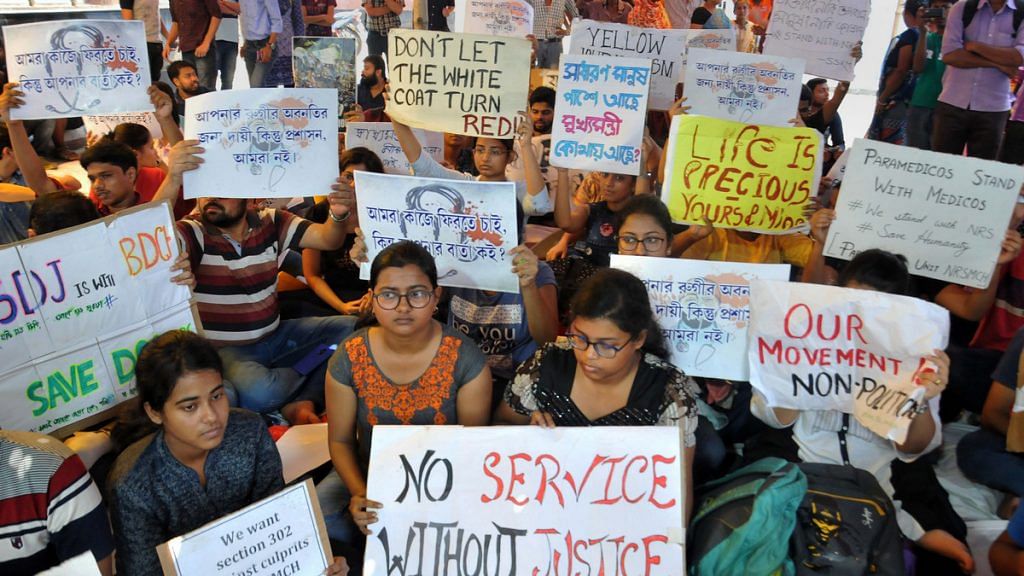We were already in trouble when, more than a decade ago, we had to make special laws to prohibit violence against doctors and nurses and in hospitals.
In a civilised society, a law singling out violence against any specific category of people would be unnecessary — in the broadest moral sense, it is as wrong to attack a doctor as it would be to attack an electrical engineer, bus driver or hairdresser. Since we do not live in a civilised society — no, really, we don’t — a law to prevent attacks on medical and emergency services personnel makes sense. For, unlike electrical engineers, bus drivers and hairdressers, they are required to treat anyone who turns up at their doors. Since it is in society’s interests that doctors and hospitals continue to abide by the Hippocratic oath, laws protecting them from personal harm are justified.
Karnataka is among the 19 states that enacted such a law in 2009. A person convicted under the Prohibition of Violence Against Medicare Service Personnel and Damage to Property in Medicare Service Institutions Act has to go to jail for three years, pay a fine Rs 50,000 and is liable to pay a penalty of twice the quantum of loss caused to the hospital. The problem is few people do. Police records show just 173 cases were registered between 2010-2017 in Karnataka, of which 23 went to trial, resulting in just three convictions. There was no case where compensation was awarded to the victim. In a recent study conducted in New Delhi’s Ram Manohar Lohia Hospital, Rohit Kumar Gohil and fellow researchers found that only 20 per cent of the cases were referred to the police and they did not find a single case where the perpetrator was punished.
Also read: Modi govt likely to bring law to protect doctors, says head of Indian Medical Association
In a widely quoted but unpublished study, the Indian Medical Association estimates that 75 per cent of doctors have encountered violence in their careers. Clearly, the existence of the law has not prevented attacks on doctors. So, what do we do? There are two popular answers: “stricter enforcement” and “stronger punishments”. Both were tried in Karnataka, with R.K. Dutta, the former DGP, ordering the police department to take serious notice of such cases, and the state’s Law Commission calling for longer sentences and bigger fines. No one, however, expects these measures to solve the problem.
But why do people beat up doctors in the first place? One reason is that people resort to violence when they do not have faith in any other way to resolve their grievances against the doctors. The other is that there is some mala fide reason usually involving avoiding paying the fees or extorting money.
Both are enabled by a general social acceptance of violence, including group violence, as a legitimate form of expression. People know that with an overstretched police force and an overburdened judiciary, they are likely to get away with anything short of murder. Doctors, nurses and hospitals will thus be encouraged to “settle” the matter instead of spending time and energy running around police stations and courts.
While we might not be able to do much in the short term about unscrupulous people trying to make money out of other peoples’ tragedy, there are things governments and hospitals can do to reduce the risk of violence.
Also read: India’s overworked doctors are trashed by all —patients, corporates & even PM Modi
An important factor that is within their power to change is information asymmetry. It often manifests as “poor communication” between the patient’s relatives and the hospital. Not only would most patients be unaware of the medical issues, but they would also be unfamiliar with hospital procedures and paperwork. Relatives usually have to make decisions under conditions of anxiety and trust deficit, and can easily attribute adverse patient outcomes to doctor’s errors or misdemeanours.
Therefore, addressing information asymmetry at the outset can diminish the impetus for subsequent violence. How can we do this? My colleagues at Takshashila have proposed the setting up of a “Patient Protection Service” that will bridge the gap between the patient and the hospital, by acting on the patient’s behalf. Being present in hospitals, but acting independently, the service can inform patients of the prices, administrative procedures, the purpose of diagnostic tests, financial schemes and so on. They can advise patients of their rights, including getting a second consultation and the channels for grievance redressal. The presence of a mutually trusted third party can help bridge the gaps that could otherwise lead to violence.
It would be a shame if the ongoing protests against the atrocity in West Bengal feeds another outrage cycle and direct moral panic in the usual demands for stricter laws and enforcement. It’s very easy for any government to make another, stricter law and announce that it will be enforced strictly. What we should be demanding is a Patient Protection Service – it will be a win-win for patients and the medical fraternity alike.
The author is the director of the Takshashila Institution, an independent centre for research and education in public policy. Views are personal.
Also read: Can a law prevent attacks on doctors or should govt address overburdened healthcare system?
